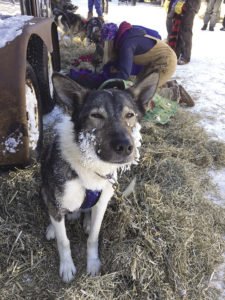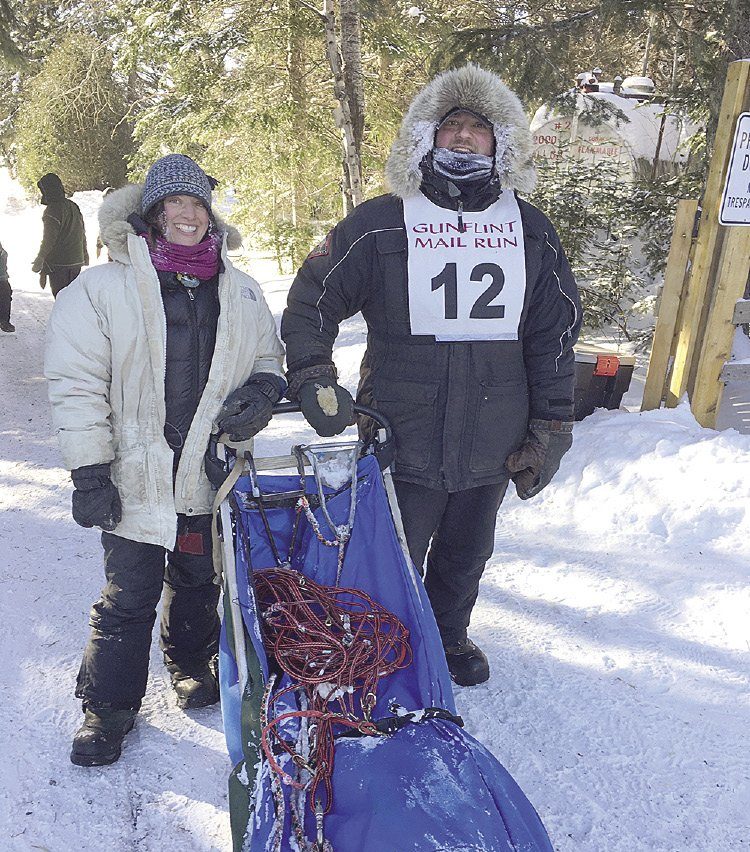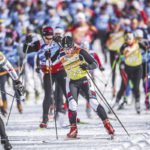In 2003, I signed on with my friend Elissa to be one of the YMCA Camp Menogyn mushers for the winter. Menogyn leases dogs for the winter season. The dogs live on site at West Bearskin Lake and two mushers care for them and run dog tours as part of Menogyn’s winter program.
Our experience began with a month living in a yurt at Doug and Deb Seim’s place (from whom Menogyn leased dogs at the time), getting to know the dogs and how to care for them. We moved in late November and there was little to no snow on the ground. Doug was recovering from surgery and unable to do much with the dogs as far as training. But he did hand us several books about mushing and imparted what knowledge and wisdom he could. I remember his first lesson.
“There are two rules in mushing,” Doug said. “Never let go of the sled. And never put your hand in a dog fight.”
I am not going to tell you that I have never broken these rules. During that first winter at Menogyn, I lost the dog team on our first run on the lake. Later, when my husband Matt and I had our own team of dogs in Wisconsin, I lost the team more than once—partly due to old, faulty equipment (there was the time I went barreling down a steep hill that had a 90 degree turn at the bottom. When the dogs hit the turn, the gangline snapped right in front of the sled and away my team of six ran without me). But that was 10 years ago. Since moving up here, I have been proud of my ability to hang on no matter what. Matt likes to tell new handlers that he would rather be dragged and mangled before losing the dog team. I flip the sled frequently and I know how to grip the handlebar and ride out the subsequent slam to the ground—sometimes with snow filling up my parka or recently, pushing my pants to my knees. I’ve torn my clothes, endured skin on ice abrasions and even been dragged by 14 crazy race-hyped huskies by a foot caught in the brake until somehow, I get a snowhook in, or the team realizes that they are not able to go as fast as they would like because of the dragging human. The thought of losing the team in the middle of nowhere with no help around is almost enough to make a person quit mushing. So, I have simply committed to hanging on.
Several weeks ago, I took a team out for a “fun run.” I planned to do a much longer training run later in the day with the A-racing team. This run was simply going to be short and fast—just wanted to get everyone some exercise. Matt and our daughter Sylvia were gone for a few days. I was on my own. I hooked up 12 dogs. About 8 miles into the run, I stopped as I often do to fix a tugline that was hooked under my leader’s leg. We were on Pine Mountain Road. I stomped in my snowhook and walked forward. I noticed Gabby had already freed herself from the problem tug line so I turned back toward the sled. The dogs lunged and the snowhook popped. Not wanting to take chances I jumped in the sled basket. I couldn’t ride in the sled basket long, so I stood and tried to step around to the back of the sled. In hindsight, I should have been more careful. The sled tipped toward me, and as I hit the ground my arms just gave out. The handlebar wrenched from my grip and it was inches and then feet from me. The dogs turned and looked back. I yelled “Whoaaaaa,” and without hesitation, they took off. I stood and started running but a 41-year-old in heavy winter gear on a packed snow trail is no match for a team of 12 huskies. They were out of my sight within minutes.

All I could do was keep running. I spent the next hour and a half willing my legs to move faster. I ditched my parka behind a tree. Every time I turned a corner on the road, I hoped I would see them waiting with tails wagging, but there was nothing. I wished a snowmobile would come along. I tried texting the one friend who I thought might be around who could come help but my text did not go through.
The danger in losing the team is this: They rely on the musher to keep the line pulled out, so that the dogs in back don’t catch up to the dogs in front and get tangled or in a fight. I knew that if Gabby stopped and the wheel dogs kept going, they could all be on top of each other, and well, it’s easy to imagine the worst. The one small shred of hope I had was that we were pointing toward home. The dogs knew the way. And the sled was on its side, which maybe would be enough back pressure, I thought, to keep everyone from getting bunched. It could also mean the sled would arrive in pieces by the time the dogs dragged it over the twists and turns of our trail.
I was 4 miles from home and I waddled my way there as fast as I could, trying to control my heavy breathing, trying to become at peace with the ache that had set into my lungs pushing cold air in and out. I finally came within sight of the dog yard, and they were there, parked in the middle, waiting patiently for me to arrive. When they saw me, they went berserk, as if to say, “what took you so long?” and “we have been waiting a really long time!”
I broke the other cardinal rule recently as well and have a few new scars to prove it. The dog fight in this case warranted intervention and it was up to me to extract a dog from an attack that could have rendered her dead. Sled dogs do on occasion display some pack mentality. The fights are few and far between but in this case, a leader turned the team backwards and the dogs behind her jumped on top. By the time I removed this dog from the fight, I was physically and emotionally battered. The dogs were fine.
I have wondered more than once this year if it’s time to hang up our hats as mushers. But then, we make it to race season, and this year in the Gunflint Mail Run, I had an astoundingly fast run with my 8-dog team, watched the Wolf Moon rise on the trail, watched a leader gain confidence with passing and two young dogs fly through the race with enthusiasm and joy that will set them up for a long future of racing. Mushing is the highest of highs and the lowest of lows. For now, I will hang on to my team another day.




